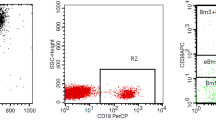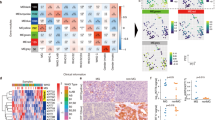Abstract
Protein tyrosine phosphatase, non-receptor type 22 (PTPN22) inhibits T-cell activation and interleukin-2 (IL-2) production. The PTPN22gain-of-function+1858T(+) genotypes predispose to multiple autoimmune diseases, including early-onset (non-thymomatous) myasthenia gravis (MG). The disease association and the requirement of IL-2/IL-2 receptor signaling for intrathymic, negative T-cell selection have suggested that these genotypes may weaken T-cell receptor (TCR) signaling and impair the deletion of autoreactive T cells. Evidence for this hypothesis is missing. Thymoma-associated MG, which depends on intratumorous generation and export of mature autoreactive CD4(+) T cells, is a model of autoimmunity because of central tolerance failure. Here, we analyzed the PTPN22 +1858C/T single nucleotide polymorphism in 426 German Caucasian individuals, including 125 thymoma patients (79 with MG), and investigated intratumorous IL-2 expression levels. Unlike two previous studies on French and Swedish patients, we found strong association of PTPN22 +1858T(+) genotypes not only with early-onset MG (P=0.00034) but also with thymoma-associated MG (P=0.0028). IL-2 expression in thymomas with PTPN22 +1858T(+) genotypes (P=0.028) was lower, implying weaker TCR signaling. We conclude that the PTPN22gain-of-function variant biases towards MG in a subgroup of thymoma patients possibly by impeding central tolerance induction.
This is a preview of subscription content, access via your institution
Access options
Subscribe to this journal
Receive 6 digital issues and online access to articles
$119.00 per year
only $19.83 per issue
Buy this article
- Purchase on Springer Link
- Instant access to full article PDF
Prices may be subject to local taxes which are calculated during checkout


Similar content being viewed by others
References
Marx A, Müller-Hermelink HK, Ströbel P . The role of thymomas in the development of myasthenia gravis. Ann N Y Acad Sci 2003; 998: 223–236.
Willcox N, Schluep M, Ritter MA, Schuurman HJ, Newsom-Davis J, Christensson B . Myasthenic and non-myasthenic thymoma. An expansion of a minor cortical epithelial cell subset? Am J Pathol 1987; 127: 447–460.
Ströbel P, Murumägi A, Klein R, Luster M, Lahti M, Krohn K et al. Deficiency of the autoimmune regulator AIRE in thymomas is insufficient to elicit autoimmune polyendocrinopathy syndrome type 1 (APS-1). J Pathol 2007; 211: 563–571.
Chuang WY, Ströbel P, Gold R, Nix W, Schalke B, Kiefer R et al. A CTLA4high genotype is associated with myasthenia gravis in thymoma patients. Ann Neurol 2005; 58: 644–648.
Bottini N, Musumeci L, Alonso A, Rahmouni S, Nika K, Rostamkhani M et al. A functional variant of lymphoid tyrosine phosphatase is associated with type I diabetes. Nat Genet 2004; 36: 337–338.
Criswell LA, Pfeiffer KA, Lum RF, Gonzales B, Novitzke J, Kern M et al. Analysis of families in the multiple autoimmune disease genetics consortium (MADGC) collection: the PTPN22 620W allele associates with multiple autoimmune phenotypes. Am J Hum Genet 2005; 76: 561–571.
Smyth D, Cooper JD, Collins JE, Heward JM, Franklyn JA, Howson JM et al. Replication of an association between the lymphoid tyrosine phosphatase locus (LYP/PTPN22) with type 1 diabetes, and evidence for its role as a general autoimmunity locus. Diabetes 2004; 53: 3020–3023.
Ueda H, Howson JM, Esposito L, Heward J, Snook H, Chamberlain G et al. Association of the T-cell regulatory gene CTLA4 with susceptibility to autoimmune disease. Nature 2003; 423: 506–511.
Zheng W, She JX . Genetic association between a lymphoid tyrosine phosphatase (PTPN22) and type 1 diabetes. Diabetes 2005; 54: 906–908.
Kyogoku C, Langefeld CD, Ortmann WA, Lee A, Selby S, Carlton VE et al. Genetic association of the R620W polymorphism of protein tyrosine phosphatase PTPN22 with human SLE. Am J Hum Genet 2004; 75: 504–507.
Michou L, Lasbleiz S, Rat AC, Migliorini P, Balsa A, Westhovens R et al. Linkage proof for PTPN22, a rheumatoid arthritis susceptibility gene and a human autoimmunity gene. Proc Natl Acad Sci USA 2007; 104: 1649–1654.
Vandiedonck C, Capdevielle C, Giraud M, Krumeich S, Jais JP, Eymard B et al. Association of the PTPN22*R620W polymorphism with autoimmune myasthenia gravis. Ann Neurol 2006; 59: 404–407.
Lee YH, Rho YH, Choi SJ, Ji JD, Song GG, Nath SK et al. The PTPN22 C1858T functional polymorphism and autoimmune diseases—a meta-analysis. Rheumatology (Oxford) 2007; 46: 49–56.
Vang T, Congia M, Macis MD, Musumeci L, Orrú V, Zavattari P et al. Autoimmune-associated lymphoid tyrosine phosphatase is a gain-of-function variant. Nat Genet 2005; 37: 1317–1319.
Bassiri H, Carding SR . A requirement for IL-2/IL-2 receptor signaling in intrathymic negative selection. J Immunol 2001; 166: 5945–5954.
Lefvert AK, Zhao Y, Ramanujam R, Yu S, Pirskanen R, Hammarström L . PTPN22 R620W promotes production of anti-AChR autoantibodies and IL-2 in myasthenia gravis. J Neuroimmunol 2008; 197: 110–113.
Anjos S, Nguyen A, Ounissi-Benkalha H, Tessier MC, Polychronakos C . A common autoimmunity predisposing signal peptide variant of the cytotoxic T-lymphocyte antigen 4 results in inefficient glycosylation of the susceptibility allele. J Biol Chem 2002; 277: 46478–46486.
Kouki T, Sawai Y, Gardine CA, Fisfalen ME, Alegre ML, DeGroot LJ . CTLA-4 gene polymorphism at position 49 in exon 1 reduces the inhibitory function of CTLA-4 and contributes to the pathogenesis of Graves' disease. J Immunol 2000; 165: 6606–6611.
Ströbel P, Helmreich M, Menioudakis G, Lewin SR, Rüdiger T, Bauer A et al. Paraneoplastic myasthenia gravis correlates with generation of mature naive CD4(+) T cells in thymomas. Blood 2002; 100: 159–166.
Buckley C, Douek D, Newsom-Davis J, Vincent A, Willcox N . Mature, long-lived CD4+ and CD8+ T cells are generated by the thymoma in myasthenia gravis. Ann Neurol 2001; 50: 64–72.
Hoffacker V, Schultz A, Tiesinga JJ, Gold R, Schalke B, Nix W et al. Thymomas alter the T-cell subset composition in the blood: a potential mechanism for thymoma-associated autoimmune disease. Blood 2000; 96: 3872–3879.
Buhlmann JE, Elkin SK, Sharpe AH . A role for the B7-1/B7-2:CD28/CTLA-4 pathway during negative selection. J Immunol 2003; 170: 5421–5428.
Kwon H, Jun HS, Khil LY, Yoon JW . Role of CTLA-4 in the activation of single- and double-positive thymocytes. J Immunol 2004; 173: 6645–6653.
Matthews RJ, Bowne DB, Flores E, Thomas ML . Characterization of hematopoietic intracellular protein tyrosine phosphatases: description of a phosphatase containing an SH2 domain and another enriched in proline-, glutamic acid-, serine-, and threonine-rich sequences. Mol Cell Biol 1992; 12: 2396–2405.
Cohen S, Dadi H, Shaoul E, Sharfe N, Roifman CM . Cloning and characterization of a lymphoid-specific, inducible human protein tyrosine phosphatase, Lyp. Blood 1999; 93: 2013–2024.
Wu J, Katrekar A, Honigberg LA, Smith AM, Conn MT, Tang J et al. Identification of substrates of human protein-tyrosine phosphatase PTPN22. J Biol Chem 2006; 281: 11002–11010.
Fend F, Kirchner T, Marx A, Müller-Hermelink HK . B-cells in thymic epithelial tumours. An immunohistochemical analysis of intra- and extraepithelial B-cells. Virchows Arch B Cell Pathol Incl Mol Pathol 1993; 63: 241–247.
Giraud M, Taubert R, Vandiedonck C, Ke X, Lévi-Strauss M, Pagani F et al. An IRF8-binding promoter variant and AIRE control CHRNA1 promiscuous expression in thymus. Nature 2007; 448: 934–937.
Acknowledgements
We thank C Siehndel, T Pohle, and J Maar for expert technical assistance; Pärt Peterson, University of Tartu, Estonia; Nick Willcox, University of Oxford; and Henri-Jean Garchon, University Paris-Descartes for critical comments. This study was supported by European Union Grants LSHB-CT-2003-503410 (Euro-Thymaide) and No. 2005105 (European Myasthenia Gravis Network) (to AM and PS); and by Grant 106430 of the Deutsche Krebshilfe (to HK M-H, PS, and AM).
Author information
Authors and Affiliations
Corresponding author
Rights and permissions
About this article
Cite this article
Chuang, WY., Ströbel, P., Belharazem, D. et al. The PTPN22gain-of-function+1858T(+) genotypes correlate with low IL-2 expression in thymomas and predispose to myasthenia gravis. Genes Immun 10, 667–672 (2009). https://doi.org/10.1038/gene.2009.64
Received:
Revised:
Accepted:
Published:
Issue Date:
DOI: https://doi.org/10.1038/gene.2009.64
Keywords
This article is cited by
-
Thymus and autoimmunity
Seminars in Immunopathology (2021)
-
Meta-analysis reveals an association of PTPN22 C1858T with autoimmune diseases, which depends on the localization of the affected tissue
Genes & Immunity (2012)
-
Lymphoid tyrosine phosphatase and autoimmunity: human genetics rediscovers tyrosine phosphatases
Seminars in Immunopathology (2010)



